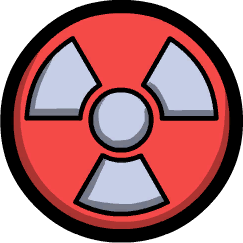 |
This article contains outdated information that is inaccurate for the current version. It was last updated for EX1-449549. Unreflected changes in the discussed game mechanics are detailed here: EX1-458490 • EX1-469287 • U35-478755 |
 |
This article is related to DLC content of Spaced Out. |
A Radbolt Engine is a rocket engine that requires Radbolts to function. Radbolts must be injected into the radbolt input port via a Radbolt Generator. Radbolt engines can travel extraordinary ranges but are limited to a relatively low rocket height in comparison to the other late game engines. Like a few engines such as the Carbon Dioxide Engine and the Steam Engine, the Radbolt Engine does not need any kind of fuel or oxidizer storage modules since it has its own internal storage. A Radbolt Engine can fly up to 20 tiles consecutively without a refuel. It has a storage capacity of 4000 radbolts and consumes 200 per tile traveled.
The temperature of the exhaust from a launch is hot enough to melt steel, in excess of 2200C. Power cables, automation wires and logic gates may need to be constructed from Tungsten, to ensure they don't get destroyed during a launch.
Tips[ | ]
Due to the fact that the Radbolt Engine produces highly contaminated Nuclear Fallout on exhaust, this same fallout can be used in combination with Radbolt Generators to drastically increase the production of Rads/cycle, as long as they are surrounded with pipes cold enough to liquefy the fallout into Nuclear Waste. The high amount of Radioactive Contaminants within the Nuclear Waste would allow the Radbolt Generators to produce extremely high amounts of Rads, going around ~1000 Rads/cycle the first time a Radbolt Engine is launched, and beyond on each consecutive launches and landings. Note that the contaminants die out quickly on their own, so repeated launches of the Radbolt Engine are required if one wishes to maintain high Rads/cycle.
Trivia[ | ]
- Its current flavor text states "Radbolt engines are faster than Hydrogen Engines but with a more restrictive height allowance." This is because, despite the fact that the base speed of a Hydrogen engine is 7.9 and the base speed of a Radbolt engine is 6.8, fuel and oxidizer tanks add burden to the rocket which in turn reduce the travel speed of the rocket. The Radbolt Engine does not need fuel tanks to lift-off, unlike the Hydrogen Engine which needs fuel and oxidizer tanks to do so. However, for practical uses, this may be misleading. Due to how engine speed is calculated, the radbolt engine is only faster if burden from non-engine modules is less than 10 (not including engine, fuel tank, and a small solid oxidizer tank) or less than 15 (for a liquid oxygen tank on the hydrogen rocket). If your rocket needs power, keep in mind that the hydrogen engine provides 600w, so if you need a single solar panel and battery on your radbolt rocket, a hydrogen with small solid oxidizer and no solar will always be faster (2 or more burden, but the lightest possible rocket is a solo spacefarer module with 3), and with liquid oxygen will be faster with just 7 extra burden.















